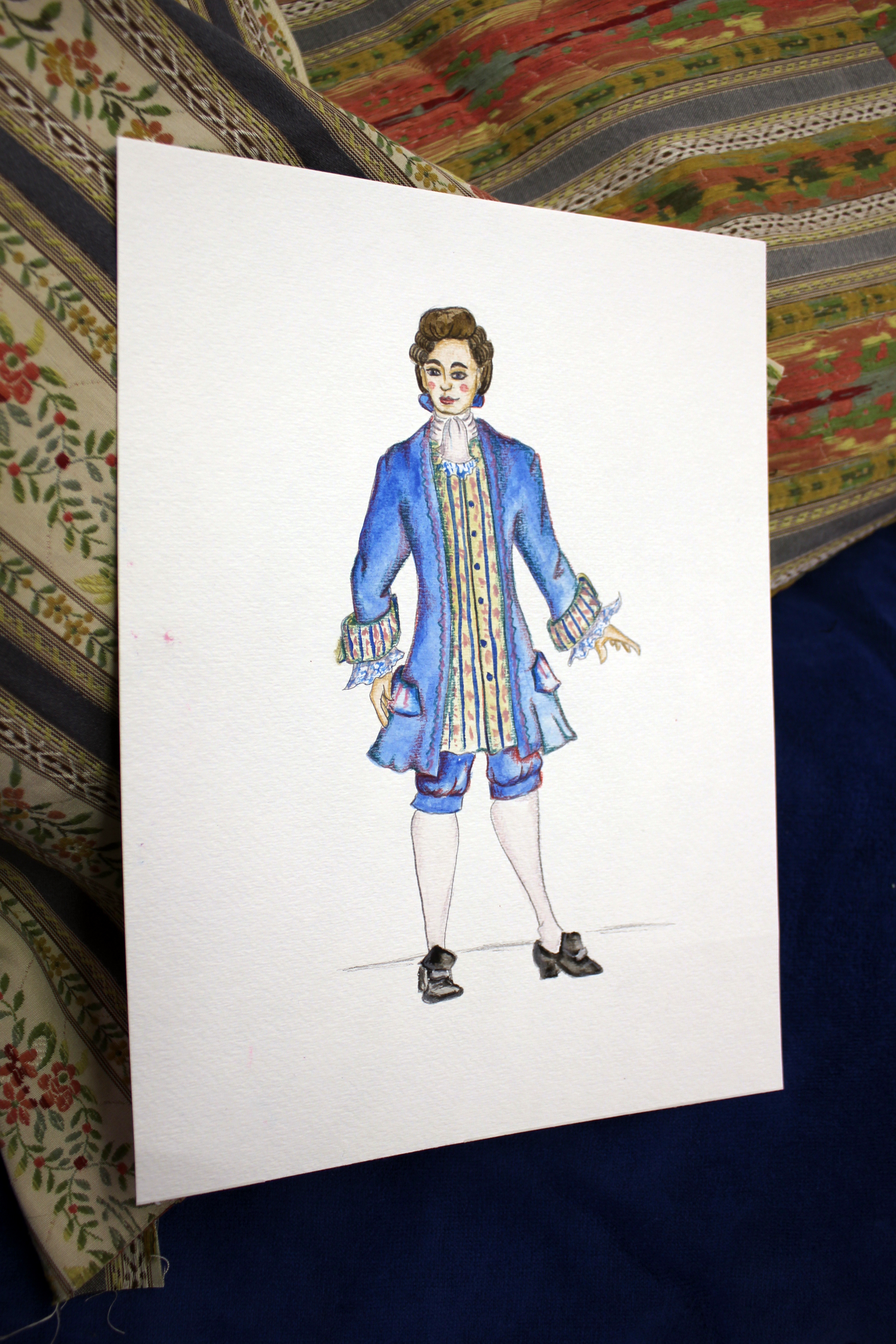GVT’s costume designer brings French frivolity with a flair to School for Lies
GVT is thrilled to bring The School for Lies to the stage this July. The audience will be in stitches during this saucy comedy, and the costumes are guaranteed to captivate theatre-goers through their use of historical, colorful frivolity, all designed in-house by resident costume designer Jenna Fawn Brown.
A student of historical clothing, Jenna Fawn is beyond excited to design the costumes for The School for Lies, a farce set in a 1666 French salon. Her costume designs use opulent barococo style to tell the visual tale of Celimene, the stylish widow, and her inner circle who populate the most fashionable salon in Paris.
Philante, The School for Lies, 2018. Rendered by Jenna Fawn Brown.
“The barococo period actually refers to a time between the late 1600s and early 1700s,” says Jenna Fawn. “It was a transitional period between two ideals and two worlds.”
David Ives’ adaptation of Moliere’s The Misanthrope is as much of a spoof of Moliere’s play as it is a by-the-book adaptation, and the way Ives plays fast and loose with historical accuracy (for instance, there is a reference to flip flops in the play) allows Jenna Fawn the leeway to play with the costuming outside of 1666.
Jenna Fawn says, “The Age of Enlightenment was also the age of ridiculous society, and this play sets out to show how society’s rules are.”
“I was inspired by the color and texture of macaroons in my costumes,” Jenna Fawn says. “The use of playful colors in the costumes reinforces the play’s humor and irreverence.”
Jenna Fawn’s use of “frivolous French flair,” as she calls it, brings visual excess to the play, as the characters are dressed like ladies and fops straight out of the time of Marie Antoinette.
The barococo time period of the late 1600s-early 1700s happens to be one of Jenna Fawn’s favorite periods of costume history.
Eliante, The School for Lies, 2018. Rendered by Jenna Fawn Brown.
“It’s a time in history where the world changed forever. Outrageous excess led to the end of frivolity with the American and French revolutions. It was the last grandiose period for clothing, where even men in this period were allowed to be a ‘fop,’ a man about town. It wasn’t taboo for a gentleman to wear as much rouge as the ladies.
“It was the last age of what I would call outrageous decadence when it comes to clothing,” she says.
Jenna Fawn says that her use of color in the characters’ costumes adds visual reinforcement to their personalities. The main character, Celimene, is a widow who is no longer in active mourning. Jenna Fawn’s costume designs for Celimene include a bit of black, “to show she still misses her husband,” along with pink and rose hues, a deliberate choice.
“For all their delicate beauty, roses can snap, bite and punch back,” says Jenna Fawn. “They’ve got those hardy stems – they’re tough flowers but they are just lovely. They represent Celimene’s balance of being both delicate and fierce.”
Another character in the play is described as being “like the sunrise.” Jenna Fawn uses that reference in choosing that character’s color palette of pinks, oranges and teals. “I do that for all the characters. I find a word that describes them, and I latch onto it to create their look.”
Other visual cues are even more subtle. If a couple is meant to be together, Jenna Fawn will visually link them by putting them in similar or complementary color palettes. If a character is dour, his or her clothing will be more sedate. And, if the character is outlandish, then she brings their costume sufficiently over the top.
Jenna Fawn invites audiences to explore her School for Lies Pinterest board on her page, @Jenna Fawn or @fawn1414. Additionally, those who may be interested in how a lady got dressed in those times, search for “Getting Dressed in the 18th Century” on YouTube.
This is Jenna Fawn’s eighth year at Greenbrier Valley Theatre. She is a graduate of Florida State University with a master’s degree in Costume Design. She designed for the Cumberland County Playhouse and the Carpetbag Theatre in Tennessee and for Virginia Stage prior to her residence in West Virginia.


